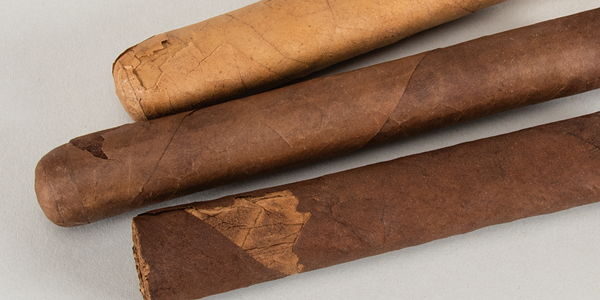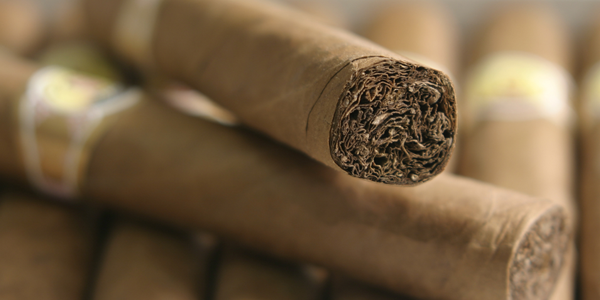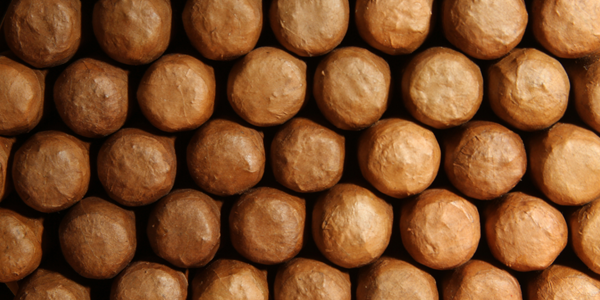How to Repair Cracked or Flaking Cigar Wrappers
We’ve already provided a thorough overview on how to remedy a handful of common cigar problems, but we’re going to elaborate on how to fix a cigar with a cracked wrapper. If the wrapper on your cigar is simply cracked in a single spot or seems to be unraveling all at once, there’s a good chance you can fix it. If the wrapper is completely flaking apart (like a potato chip) over the entirety of the cigar, it may be beyond the point of no return. If you smoke a cigar with a cracked wrapper, it will not burn evenly and it won’t taste good.
Common Causes for a Cracked Cigar Wrapper
Here are the common causes a cigar’s wrapper will crack or flake:
- Too little humidity (dry or improper storage)
- Seasonality (colder, dryer weather)
- Improper transport (taking a cigar in and out of your pocket without cellophane or protection around the cigar)
- Improper cutting (or using a dull cutter)
- Knocking the cigar against an ashtray too aggressively
- Removing the cigar band before the cigar is lit
Too little humidity is the biggest issue. If your cigar has been out of a humidor for too long (several days) or you neglect to refill the reservoir in your humidor, the wrapper is often the first thing to go. It shrivels up or flakes off in places when a cigar hasn’t been humidified. Keeping your cigars fresh and humidified is the easiest way to prevent a cracked wrapper.
Another factor to consider is the type of wrapper. For example, Cameroon and Indonesian wrappers are more fragile than other varietals. Because they are less resilient, there is a greater chance they can crack or unravel if the weather is cold or dry. Connecticut Broadleaf wrappers are naturally heartier than Connecticut Shade. That doesn’t mean you have to give up your favorite Cameroon or Connecticut Shade cigars. You simply want to be a little more vigilant in keeping them fresh. Regardless of how your cigar wound up in its compromised state, there are a couple of ways to repair a cracked wrapper leaf on a cigar.
How to Repair a Cracked Wrapper
Repairing a Wrapper with Pectin
The first and most effective method is to use pectin, which is a white to light brown powder or solution. Pectin is a citrus fruit extract, primarily used as a gelling agent in jams and jellies. Because it is tasteless and odorless, it’s a practical and harmless substance for patching up a cigar’s wrapper. An alternative to pectin is gum arabic (or acacia powder). When mixed with a touch of distilled water, you can apply it to a cigar wrapper leaf to seal it back into place.
Using a Piece of Wrapper Leaf from Another Cigar
If your cigar is missing a chunk of wrapper leaf in the mid-section, you can always consider peeling a bit of wrapper leaf from a less expensive cigar and reapplying it to the cigar you want to smoke. This method, although not ideal, is worth considering if you’ve got an expensive or rare cigar with a damaged wrapper leaf. No one wants to toss out a Padron Family Reserve or something you’ve been saving for a special occasion because the wrapper cracked.
In a Pinch, Use Chapstick or Vaseline
If you’re in need of a quick impromptu wrapper leaf repair, you may be able to get away with a dab of ChapStick or Vaseline lip balm. Honey, syrup, or cola might do the trick, too, because they are naturally sticky. It’s worth a shot when you’re out and about and need a quick fix.
Although the first instinct for a lot of guys is to lick a cracked wrapper or use their saliva to seal the wrapper back in place, these methods rarely prove effective. Eventually your saliva dries and the wrapper leaf will continue to come apart as it did before.
How to Prevent a Cracked or Flaking Wrapper
Maintain the Humidity in Your Humidor
The best way to deal with cracked cigar wrappers is to prevent them from occurring in the first place. Maintain the humidity in your humidor. Keep an eye on your hygrometer and make sure it’s in the 65-70% RH (relative humidity) vicinity on a regular basis. If your cigars are cracking in your humidor, they’re too dry.
When taking a cigar or two to your next cigar-smoking destination, put them in a ziplock bag to protect them, even if they come in cellophane. Better yet, invest in a travel humidor, a cigar case, or a Boveda Humidor Bag. If you travel frequently with your cigars, a well-made cigar case will protect your cigars and keep them fresh.
Invest in a Sharp Cigar Cutter
Make sure your cigar cutter has sharp blades. A dull cutter can crack the wrapper leaf if you’re struggling to the snip the end off, especially if you cut it too deeply. Applying too much pressure during a cut stresses the wrapper and can cause it to split. Many brands like Xikar offer a lifetime warranty on their products and they will repair or replace the blades for free.
Wait to Remove the Band
When you light up, wait until you’ve smoked the first half to two-thirds of your cigar before you take the band off. A tiny bit of gum arabic holds the cigar’s band in place. Tearing the band off a cold cigar can cause part of the wrapper leaf to tear off too. After you’ve been smoking for a bit, the heat from the lit end of your cigar will cause the gum arabic on the band to loosen and you can easily peel it away.
Avoid Extreme Temperatures
Don’t leave your cigars out in a cold car overnight or sitting on the dashboard under direct sunlight during a searing hot day. Wild swings in temperature and humidity are bad for cigars. Cigars are like sponges. They will expand and contract as the humidity and temperature change. Consistency is best.
Ash with Caution
Be gentle when ashing your cigar. Softly twist the ash off into an ashtray. Banging or needlessly knocking your cigar against the side of an ashtray can also cause the wrapper to crack. Although for some it’s tempting, you don’t have to ash your cigar after every puff. Take your time smoking. Nothing should be rushed when you want to enjoy a cigar.






